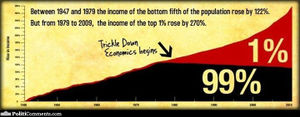Difference between revisions of "The one percent"
Jump to navigation
Jump to search
(top 1% of super-PAC donors) |
(more stats from PolitiFact) |
||
| Line 8: | Line 8: | ||
This disproportionality is an effect of [[economic disparity]], which has been increasing continuously since the late 1970s when employee wages stopped reflecting continued productivity gains. | This disproportionality is an effect of [[economic disparity]], which has been increasing continuously since the late 1970s when employee wages stopped reflecting continued productivity gains. | ||
| + | {{seedling}} | ||
===Statistics=== | ===Statistics=== | ||
* (2012 Super-PACs) The top 1% of donors (about 94 donors) give 54% of the money. [http://www.opensecrets.org/outsidespending/donor_stats.php] | * (2012 Super-PACs) The top 1% of donors (about 94 donors) give 54% of the money. [http://www.opensecrets.org/outsidespending/donor_stats.php] | ||
* The [[gross domestic product]] of the poorest 48 nations is less than the wealth of the world's richest 3 people. ''(from image-meme; source needed)'' | * The [[gross domestic product]] of the poorest 48 nations is less than the wealth of the world's richest 3 people. ''(from image-meme; source needed)'' | ||
| − | + | * In 2009, the Forbes 400 -- the wealthiest 0.0000035% of Americans -- have more wealth than the bottom 50% combined. [http://www.politifact.com/wisconsin/statements/2011/mar/10/michael-moore/michael-moore-says-400-americans-have-more-wealth-/ PolitiFact] | |
| + | ** In 2010, they had more wealth than the bottom 60% combined -- more than 100 million households. | ||
| + | * The [[Wal-Mart]] heirs alone have more wealth than the bottom 40% combined. [http://www.politifact.com/truth-o-meter/statements/2012/jul/31/bernie-s/sanders-says-walmart-heirs-own-more-wealth-bottom-/ PolitiFact] | ||
Revision as of 12:04, 7 January 2013
About
The 1% refers specifically to the top 1% of earners in any given economy -- most commonly the United States, but it can also refer to other countries or even the global economy. More generally, it refers to the fact that a very small segment of society owns a disproportionately large percentage of society's wealth, a disproportionality which intensifies as you look at smaller and smaller pieces of the top percentiles.
This disproportionality is an effect of economic disparity, which has been increasing continuously since the late 1970s when employee wages stopped reflecting continued productivity gains.
Statistics
- (2012 Super-PACs) The top 1% of donors (about 94 donors) give 54% of the money. [1]
- The gross domestic product of the poorest 48 nations is less than the wealth of the world's richest 3 people. (from image-meme; source needed)
- In 2009, the Forbes 400 -- the wealthiest 0.0000035% of Americans -- have more wealth than the bottom 50% combined. PolitiFact
- In 2010, they had more wealth than the bottom 60% combined -- more than 100 million households.
- The Wal-Mart heirs alone have more wealth than the bottom 40% combined. PolitiFact
